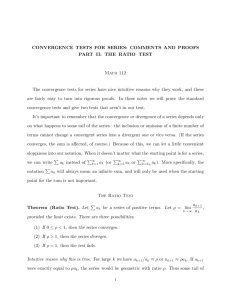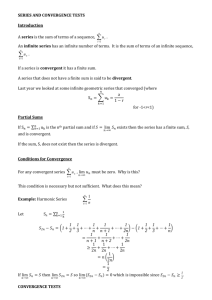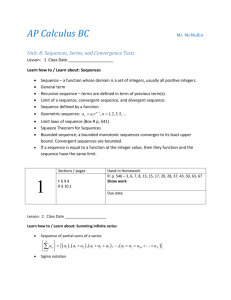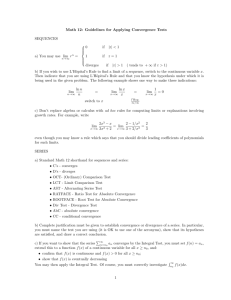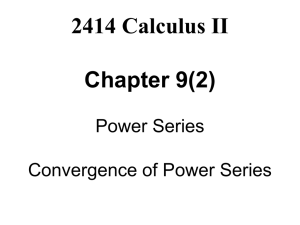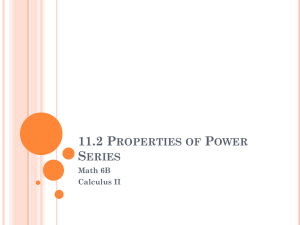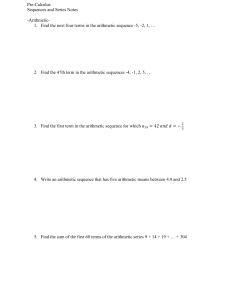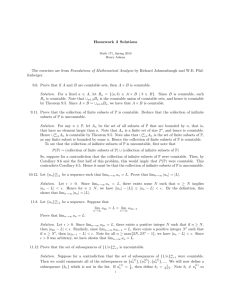LECTURE 8: REVIEW OF POWER SERIES Let us remember the
advertisement
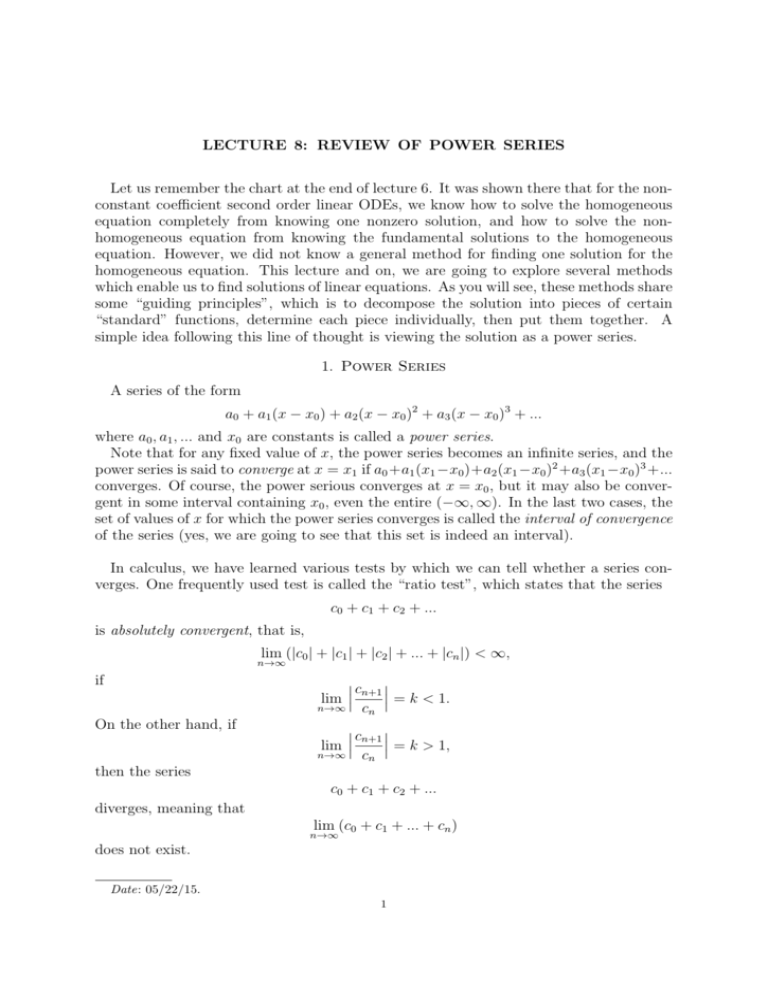
LECTURE 8: REVIEW OF POWER SERIES
Let us remember the chart at the end of lecture 6. It was shown there that for the nonconstant coefficient second order linear ODEs, we know how to solve the homogeneous
equation completely from knowing one nonzero solution, and how to solve the nonhomogeneous equation from knowing the fundamental solutions to the homogeneous
equation. However, we did not know a general method for finding one solution for the
homogeneous equation. This lecture and on, we are going to explore several methods
which enable us to find solutions of linear equations. As you will see, these methods share
some “guiding principles”, which is to decompose the solution into pieces of certain
“standard” functions, determine each piece individually, then put them together. A
simple idea following this line of thought is viewing the solution as a power series.
1. Power Series
A series of the form
a0 + a1 (x − x0 ) + a2 (x − x0 )2 + a3 (x − x0 )3 + ...
where a0 , a1 , ... and x0 are constants is called a power series.
Note that for any fixed value of x, the power series becomes an infinite series, and the
power series is said to converge at x = x1 if a0 +a1 (x1 −x0 )+a2 (x1 −x0 )2 +a3 (x1 −x0 )3 +...
converges. Of course, the power serious converges at x = x0 , but it may also be convergent in some interval containing x0 , even the entire (−∞, ∞). In the last two cases, the
set of values of x for which the power series converges is called the interval of convergence
of the series (yes, we are going to see that this set is indeed an interval).
In calculus, we have learned various tests by which we can tell whether a series converges. One frequently used test is called the “ratio test”, which states that the series
c0 + c1 + c2 + ...
is absolutely convergent, that is,
lim (|c0 | + |c1 | + |c2 | + ... + |cn |) < ∞,
n→∞
if
On the other hand, if
c n+1 lim = k < 1.
n→∞
cn
c n+1 lim = k > 1,
n→∞
cn
then the series
c0 + c1 + c2 + ...
diverges, meaning that
lim (c0 + c1 + ... + cn )
n→∞
does not exist.
Date: 05/22/15.
1
2
LECTURE 8: REVIEW OF POWER SERIES
One may ask, what if
c n+1 lim = 1?
n→∞
cn
The answer is indefinite. Consider the following three series, which all satisfy this above
equality:
1 1
1
(1)
1 + + + ... + + ...
2 3
n
1
1 1
(2)
1 − + − ... + (−1)n−1 + ...
2 3
n
1
1
1
(3)
1 + 2 + 2 + ... + 2 + ...
2
3
n
Here, series (1) is divergent, series (2) is convergent but not absolutely convergent, series
(3) is absolutely convergent (hence convergent).
Applying the ratio test to the power series
a0 + a1 (x − x0 ) + a2 (x − x0 )2 + a3 (x − x0 )3 + ...,
the three statements above become:
• If
a a (x − x )n+1 n+1 n+1
0
=
|x
−
x
|
lim
lim = k < 1,
0
n
n→∞
n→∞
an (x − x0 )
an
then the power series
a0 + a1 (x − x0 ) + a2 (x − x0 )2 + a3 (x − x0 )3 + ...
converges absolutely.
• If
a (x − x )n+1 a n+1 n+1
0
lim = |x − x0 | lim = k > 1,
n
n→∞
n→∞
an (x − x0 )
an
then the power series
a0 + a1 (x − x0 ) + a2 (x − x0 )2 + a3 (x − x0 )3 + ...
diverges.
• If
a (x − x )n+1 a n+1
n+1 0
lim =
|x
−
x
|
lim
= 1,
0
n→∞
n→∞
an (x − x0 )n
an
it is indefinite in general whether
a0 + a1 (x − x0 ) + a2 (x − x0 )2 + a3 (x − x0 )3 + ...
converges or diverges.
plays a crucial role here in determining:
As we can see, the limit of ratios limn→∞ an+1
an
for which values of x the power series is convergent or divergent. With this in mind, let
us define the radius of convergence of the power series a0 + a1 (x − x0 ) + a2 (x − x0 )2 +
a3 (x − x0 )3 + ... to be
(
= 0,
∞,
limn→∞ an+1
an an+1 −1
an+1
ρ=
limn→∞ an ,
limn→∞ an > 0.
LECTURE 8: REVIEW OF POWER SERIES
3
Therefore, corresponding back to the ratio test, we have that the power series is convergent on (x0 − ρ, x0 + ρ), divergent on (−∞, x0 − ρ) ∪ (x0 + ρ, ∞), and is indefinite (or
dependent on the specific expression of the power series) at the end-points x0 − ρ and
x0 + ρ when ρ < ∞. Now, we can argue that the set of x-values at which a power series
is convergent forms an interval (open, closed or half-closed). Do you see why?
Examples.
(1) The series
1 + 1!x + 2!x2 + 3!x3 + ... + n!xn + ...
converges only at x = 0 and diverges everywhere else, because
(n + 1)! lim = lim (n + 1) = ∞.
n→∞
n→∞
n!
Thus, the radius of convergence ρ equals to zero.
(2) The series
1
1
1
1
1 + x + x2 + x3 + x4 + ... + xn + ...
2
3
4
n
is convergent on the half-closed interval [−1, 1) because on the one hand, its radius of
convergence is
1/(n + 1) −1
ρ = lim = 1,
n→∞
1/n
on the other hand, it is convergent at x = −1 but divergent at x = 1.
(3) The series
1
1 2 1 3
x + x + ... + xn + ...
2!
3!
n!
is convergent on the entire (−∞, ∞) because its radius of convergence is ∞ since
1/(n + 1)! lim = 0.
n→∞
1/n!
1+x+
*(4) The series
1
1
1
1 + x2 + x4 + x6 + ... + x2n + ...
2
3
n
has the interval of convergence (−1, 1), but it seems that the ratio test does not directly
tell us this. In fact, if we calculate
an+1
,
an
does
it equals zero when n is even and ∞ when n is odd, hence the limit limn→∞ an+1
an
not exist (not even equal to ∞). However, there is a way to use the ratio test indirectly.
Take z = x2 , of course, z ≥ 0, the power series then becomes
1
1 + z + z 2 + ...
2
which has the convergence interval (−1, 1). Note that z ≥ 0. Therefore, in x, the interval
of convergence consists those x satisfying z = x2 ∈ [0, 1), i.e., x ∈ (−1, 1). Side Note: If
your are familiar with the Taylor expansions of sin x and cos x, and are trying to use the
ratio test determine their radii of convergence, you’d probably think of the trick used in
4
LECTURE 8: REVIEW OF POWER SERIES
this exercise.
Theorem. The power series
a0 + a1 (x − x0 ) + a2 (x − x0 )2 + a3 (x − x0 )3 + ...
defines a continuous function on the open interval (x0 − ρ, x0 + ρ), where ρ is its radius
of convergence.
The following theorem tells us what the derivative of a power series is in its interval
of convergence.
Theorem. Under the same conditions as in the preceding theorem, and let
f (x) = a0 + a1 (x − x0 ) + a2 (x − x0 )2 + a3 (x − x0 )3 + ...,
x0 − ρ < x < x0 + ρ.
Then
f 0 (x) = a1 + 2a2 (x − x0 ) + 3a3 (x − x0 )2 + ...,
x0 − ρ < x < x0 + ρ.
We are not going to prove these theorems in this course, but instead ask a natural
question that follows the theorems: if f (x) is such a continuous function, how do the
coefficients in the power series relate to f (x)? Of course, you may be thinking of the
Taylor series. So let us derive the formulas for all the coefficients ai .
First, let us assume that on (x0 − ρ, x0 + ρ),
f (x) = a0 + a1 (x − x0 ) + a2 (x − x0 )2 + a3 (x − x0 )3 + ...
Take x = x0 and immediately we have
f (x0 ) = a0 .
Take x = x0 in the expression of f 0 (x), and we have
f 0 (x0 ) = a1 .
Now apply the second theorem above to the function f 0 (x), we get
f 00 (x) = 2!a2 + 3 · 2a3 (x − x0 ) + ...,
x0 − ρ < x < x0 + ρ.
Again, evaluating this expression at x0 gives
f 00 (x0 ) = 2!a2 .
Now you may have seen the pattern, the expression for f (n) (x) is
f (n) (x) = n!an + (n + 1)n...2an+1 (x − x0 ) + ...,
x0 − ρ < x < x0 + ρ.
Hence, for the same reason as before,
f (n) (x0 ) = n!an .
To summarize, if the power series
f (x) = a0 + a1 (x − x0 ) + a2 (x − x0 )2 + a3 (x − x0 )3 + ...
is convergent on (x0 − ρ, x0 + ρ), then
an =
f (n) (x0 )
.
n!
LECTURE 8: REVIEW OF POWER SERIES
5
And the power series
f (x0 ) + f 0 (x0 )(x − x0 ) +
f 00 (x0 )
f (n) (x0 )
(x − x0 )2 + ... +
(x − x0 )n + ...
2!
n!
is called the Taylor expansion of f (x) in a neighborhood of x0 .
2. Shift of Summation Index
P
Using the summation notation, a1 + ... + an can be conveniently written as ni=1 ai . Of
course, P
there is no restriction to choosing the symbol i as the index. In fact, writing the
sum as nj=1 aj is also valid. The indices i and j in the summation expressions are called
“dummy indices” because they are merely place-holders and do not appear in the result
of the sum. Essentially,
Pn+15we do not even need to have j to start strictly from 1 and end at
n. The expression k=15 ak−15 represents exactly the same summation a1 + a2 + ... + an ,
because, despite a different range of the dummy index, what’s being summed up remains
unchanged.
The observation in the previous paragraph applies to the case of power series. In
2
the power series a0 + a1 (x − x0 ) + a2 (x − x0 )P
+ ..., the form of a general term is
n
n
an (x − x0 ) , hence the series can be written as ∞
n=0 an (x − x0 ) representing the limit
PN
limN →∞ n=0 an (x − x0 )n . Again, there is no restriction in our choice of the symbol n as
the index, nor there
to choosing
value of the index.
P−∞ zero as the starting
P is any restriction
10−k
n−2
a
(x
−
x
)
both
represent the
a
(x
−
x
)
and
The expressions ∞
0
0
k=10 10−k
n=2 n−2
same power series.
Through the following exercise, we will learn how to shift the index to obtain certain
desired forms of the summation. One reason for this is that sometimes, we need to
compare two or more power series, so it would be convenient if we are looking at the
corresponding terms of the same power of x.
Exercise. Put the following power series in the summation form in which the power of
(x − x0 ) is the dummy index n:
∞
X
nan x
n−1
+ 2x
n=1
∞
X
an x n .
n=0
Answer. Letting m = n − 1 in the first sum, we have that m starts from zero and goes
to infinity. Similarly, let k = n + 1 in the second sum. Therefore,
∞
X
=
=
nan xn−1 + 2x
∞
X
n=1
n=0
∞
X
m
an x n
(m + 1)am+1 x + 2
∞
X
m=0
∞
X
∞
X
m=0
k=1
(m + 1)am+1 xm + 2
an xn+1
n=0
ak−1 xk .
6
LECTURE 8: REVIEW OF POWER SERIES
Now since m, k are dummy indices, we could replace them by n, obtaining
∞
X
n
(n + 1)an+1 x + 2
n=0
=a1 +
∞
X
an−1 xn
n=1
∞
X
((n + 1)an+1 + 2an−1 )xn .
n=1
3. Appendix: The Notion of Convergence
When we say that a sequence {an } tends to 1, or converges to 1, what do we exactly
mean? You can say, these numbers an “approach” 1 as n gets larger. But, again, what
does “approach” mean exactly? If you think about this for a while, you will perhaps
notice that “approaching” implies that one could put a “window” near the value 1, say
the open interval (0.9, 1.1), and there exists a moment after which all the an ’s are within
this “window”. Moreover, one could set this “window” to be however small he likes, and
the moment being described always exists. It is probably because of this intuition, we
have the formal definition for {an } to be convergent, which lies at the base of the subject
of mathematical analysis:
Definition. An infinite sequence of real numbers {an }∞
n=0 is said to be converging
to a if for any positive number > 0 (i.e., half the size of our “window”), there exists a
positiver integer N (i.e., the described “moment”), such that for all n > N , |an − a| < (i.e., all the future numbers in the sequence lie in the “window”).
Now, using this notion of convergence, we prove the first two claims of the ratio test
for infinite series. To be precise, we prove the claims for special values of k’s
P∞just to
make the argument easier to understand. First,
note
that
an
infinite
series
i=1 an is
Pn
∞
equivalent to the sequence {sn }n=1 where sn = i=1 ai is the sum of the first n terms in
the infinite series. For all n, such sn are called partial sums of the infinite series.
Statement 1: Given an infinite series
a0 + a1 + ... + an + ...,
= k < 1, then the series converges absolutely.
if limn→∞ an+1
an
= 0.8, if we set the
Proof for the special case k = 0.8: Because it is given limn→∞ an+1
an
window around 0.8 to be
(0.7,
0.9), then there exists a positive integer N such that for all
< 0.9. Now the infinite series s = |a0 | + |a1 | + ... + |an | + ...
n > N , we have 0.7 < an+1
an
can be viewed has having two parts, one is
sN = |a0 | + ... + |aN |,
which is clearly a finite number; the other is
s − sN = |aN +1 | + ... + |a2N | + ...
LECTURE 8: REVIEW OF POWER SERIES
7
Now note that the ratio between two successive terms starting from index N + 1 is less
than 0.9, which means,
|aN +k |
|aN +k | |aN +k−1 |
|aN +k | =
|aN +k−1 | =
|aN +k−2 |
|aN +k−1 |
|aN +k−1 | |aN +k−2 |
|aN +k | |aN +k−1 | |aN +1 |
= ... =
...
|aN | < 0.9k |aN |.
|aN +k−1 | |aN +k−2 | |aN |
Therefore,
1
s − sN < (0.9 + 0.92 + 0.93 + ...)|aN | =
|aN | = 10|aN |,
1 − 0.9
which is finite. Combining with the fact that sN is finite, we know that the sum
|a0 | + |a1 | + ... has to be finite. A theorem says, if a sequence of numbers is nondecreasing and bounded from above by a finite number, then it converges. Now our
sequence {|a0 | + ... + |an |}∞
n=0 is non-decreasing and bounded by a finite number. Therefore, it converges, i.e., the original series converges absolutely.
Statement 2: Given an infinite series
a0 + a1 + ... + an + ...,
an+1 if limn→∞ an = k > 1, then the series diverges.
Proof for the special case k = 1.2: For the same reason as before, we can set a window
around 1.2 to
be (1.1, 1.3), and there exists a positive integer N such that for all n > N ,
< 1.3. And we could assume without loss of generality that aN 6= 0.
1.1 < an+1
an
Therefore,
|aN +k |
|aN +k | |aN +k−1 |
|aN +k | =
|aN +k−1 | =
|aN +k−2 |
|aN +k−1 |
|aN +k−1 | |aN +k−2 |
|aN +k | |aN +k−1 | |aN +1 |
...
|aN | > 1.1k |aN |.
= ... =
|aN +k−1 | |aN +k−2 | |aN |
To finish the proof, again, we cite a theorem: if the series a0 + a1 + ... + an + ... is
convergent, then ak → 0 as k → ∞. In our case, {an } can never tend to zero because
|aN +k | > 1.1k |aN | > |aN | for any positive integer k. Therefore, the original series is
divergent.

